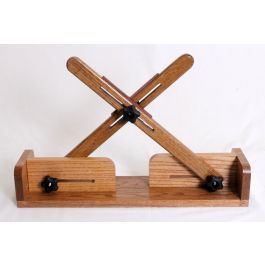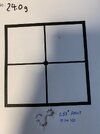JimIF you're running a 1:18 twist, the 405s are in the "lite" arena. 2MOA with store bought bullets really isn't bad. Are you using a wind flag?
You can try segregating your bullets into weight lots. Also, I never went as small as 3 shot groups, often I'd shoot 10, because that's a bank of animals and learning you're blow tube use an how a load reacts is just as important as MOA size.
Honestly, IMHO you're overthinking the barrel vibration thing. I competed with some very, very, good shots and none of them sweat that. It "briefs well" and sounds technical and all, but IMHO consistency is more important. It really is a big thick barrel. IF you're doing your load development from that rest spot, then it's incorporated in your load.. in theory. Guys used little crossed sticks that sat on their bench for load development.

Bench Cross Sticks AKA Bench Shooting Sticks
Custom Oak BPCR Bench Cross Sticks: Many shooters prefer to test their rifle's loads using bench cross sticks to replicate as close as possible the shooting position they use in competition. That is where bench rest shooting sticks come in! Using these shooting sticks eliminates a variable in...www.buffaloarms.com
I have 3 BPCRs; Shiloh 74 in .45-100, Ballard R&C 1885 in .45-90 and Ballard R&C 1885 in .40-70Win and I got all of them to just sub MOA resting on the same approximate spot on the barrel. Just because that's where I like my sticks. IF the harmonics mattered that much, what are the odds??
It's not a smokeless HV cartridge, shooting technique is more important due to the dwell time and the lock time. Even if you're shooting smokeless at a little higher MV. We used to joke about how much harder it was to shoot a 74 well due to the massive side hammer torque, but in part it's true. Part of the reason why, the center hammers, then the striker fired (Borchardt), came to dominate the matches back in the 1800s.
There's no shortcut here, practice and you'll learn the rifle. A and AA shooters debated stuff like harmonics, and loads going transonic at the Turkey bank, etc. etc. etc. meanwhile the AAA and Master class guys just practiced a lot.
Get one of these:

.22 Adapter for .40 and .45 cal. rifles
This unit uses an ingenious shell holder adapter that holds the cartridge into the chamber of the liner. The shell holder then is struck by your rifles firing pin.stores.leeshavergunsmithing.com
I had one, then finally had a custom Ballard R&C .22LR Low-Wall built to mimic my .45-90 and .40-70W.
Chuck T is giving you some really solid advice and has the experience to back it up. Learn from the folks that are describing how to do something based on what has worked for them and pass on the folks that live to be contrary and think they know it all.


